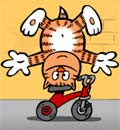Oh My Goodness this blog has become so longwinded, unorganized, chaotic, nonsensical and incoherent that it will take me some time to upload it to the Interwebz as I had intended it with all the pictures and stuff. Currently only the normal rules of the game are covered and even that isn't done all too comprehensively. Thank you for your understanding & patience. 206 edits so far. You can read the older blog entries while this one is under contruction. More to come after the commercial break. Stay tuned.
ORIGINAL CHESS®
The following Heinzk blog entry is loosely based on documents such as
FIDE's Laws of Chess, László Polgár's Reform-chess introduction and the Stratego manual.
I hope to extend this entry over time, so it will eventually completely cover "everything" related to this children's game called "Chess".
Maybe that is a tad overambitious considering the current state of affairs, but I can hope.
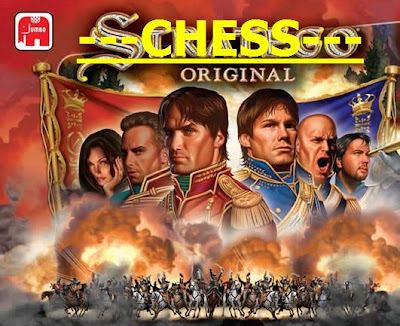
Spelregels - Règles du jeu - Spielregeln
Rules of the game - Spelregler - Spilleregler
Regole del gioco - Reglas del juego
TABLE OF CONTENTS
Check if all action figures are included in the Jumbo Chess-box®; 16 white ones and 16 black ones. Don't forget to put all pieces back in the specially designed Chess-box® after the game has ended, or you might end up losing a pawn or two.
"AFTER THE GAME, THE KING AND PAWN GO BACK INTO THE SAME BOX!!" cried an angry chessplayer once, when he noticed a pawn was missing and he was forced to use a checkers piece until one of his pawns was captured.
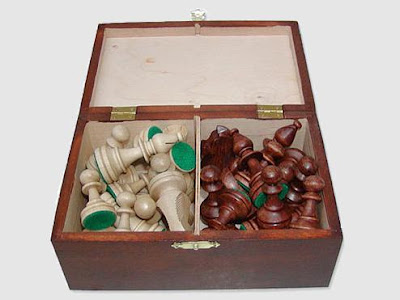
|  1 1 |
 1 1 |
 2 2 |
 2 2 |
 2 2 |
 8 8 |
| NL | koning | dame | toren | loper | paard | pion |
| F | roi | dame | tour | fou | cavalier | pion |
| D | König | Dame | Turm | Läufer | Springer | Bauer |
| GB | king | queen | rook | bishop | knight | pawn |
| S | kung | dam | torn | löpare | springare | bonde |
| DK | konge | dronning | tårn | løber | springer | bonde |
| I | re | donna | torre | alfiere | cavallo | pedone |
| E | rey | dama/reina | torre | alfil | caballo | peón |
ORIGINAL CHESS ® NL
Schaken is een supergaaf familiespel dat al vele eeuwen gepracticeerd wordt over de hele wereld.
ORIGINAL CHESS ® F
L'échecs est un jeu d'enfants pas mal.
ORIGINAL CHESS ® D
Schach ist sehr schön und richtig toll.
ORIGINAL CHESS ® S
Schack är ett bräd- och strategispel för två deltagare.
(oh come on cut out this crap... use English plz)
ORIGINAL CHESS ® GB
ATTACK AND... CHECK-MATE® THE KING.
PLAYERS: 2
PLAYING TIME: life sentence
AGES: 8-88

White attacks on the Queenside. Is the defense strong enough?!
Your opponent attacks your King. Bluff or not?
You destroy your opponent's pawn structure. Decisive or not?
Your King is protected by a Rook. Is the King safe enough now?

ATTACK AND... CHECK-MATE® THE KING.
Chess is a game full of adventures and unpleasant surprises.
You are in control of a 16-headed army of varying ranks.
You are the commander-in-chief.
You are awesome.
Your mission: to conquer your opponent's King before he gets to yours. Surpass your opponent in any way conceivable.
First of all, you are going to play your home-prepped opening. Of course you make sure your opponent doesn't know what opening you are going to play this time. You keep your King safe, but simultaneously intend to keep alive your chances to attack. Then the real battle begins.
You poke around your opponent's pieces to get a better comprehension of the strong and weak parts of the positions of his pieces on the board. Will your army prove to be strong enough?
Yes! It is time to launch the decisive attack...
 A good chess player:
A good chess player:
- is courageous and never backs down
- has a strong memory
- is able to fathom his opponents
- creates his own chances
- jumps on the chances when they are available
- chooses the right moments to launch attacks
- manipulates and screws his opponents
- wins!
Caution: Not suitable for children under three years of age due to small parts, poopy diapers and undeveloped brainz.
Original Chess® is a two-player game of attack and defense in which tension and surprise are important elements.
The game in brief; the nature and objectives of the game of Chess®
The game of chess is played between two persons who move their pieces alternately on an 8x8 board, also called a Chess-board®. Both players are in control of an army of 16 pieces, which includes a King. The object of the game is to captivate your opponent's King.
Before the game starts, you deploy the troops like this:

Important: the square on the bottom right is light. The Queens stand on their colour; the white Queen on a white square (d1) and the black Queen on a black square (d8). The eight vertical columns of squares are called files (a, b, c, d, e, f, g, h). The eight horizontal rows of squares are called ranks (1, 2, 3, 4, 5, 6, 7, 8). A straight line of squares of the same colour, running from one edge of the board to an adjacent edge is called a diagonal.
Preparation
1. Before playing for the first time or after a long hiatus: have your opponent explain the rules to you once again. In case you lose, you can always yell at him for not explaining the rules to you properly.
2. Decide who is to play with which colour. If no agreement is found, just flip a coin.
3. Decide upon the time control and set the clocks. In case all time is used up for one player (00:00), the Skull® can be clicked by the other; this awards him the win.
4. Place the chessboard on the table in between you and your opponent. Make sure the square on the bottom left is dark. If not, rotate the board 90°.
5. The pieces are meticulously set up on the two rows nearest to each player, one piece to each square. Setting up is an important part of the game; victory or defeat can depend on it. A few strategical and tactical tips are given at the end of these rules.
6. When both you and your opponent are ready, the player who plays with the black pieces (after this: "Black") starts the clocks and it is the player of the white pieces's (after this: "White") turn to move.
Playing the game
White begins! One turn consists of moving one piece of one's own colour (!) from one square to another, after which the obligation to move passes on to the other player. Each move must be made with one hand only, even castling and capturing opponent's pieces. Don't forget to tap the clock (with the same hand) after making a move on the board.
You are never allowed to move a piece of your opponent. You'll be sure to get punched in the face for that.
Moving; the moves of the pieces
The pieces and their particular ways of moving around
1. PAWNS
(The pawn, Der Bauer, Le pion, El peón, A gyalog)
The white pawns go up the board, the black pawns go down the board (similar to when football hooligans clash). A pawn may never move nor capture backwards. If a pawn is still on its own second rank, it may move either one or two squares forwards, provided both squares in front of it are unoccupied. After its first move it may only advance one square at a time; once again provided the square in front of it is not occupied by any other piece. Pawns move straight, but when capturing they move diagonally one square forwards, either to the left or to the right. Kinda wicked but you've got to live with it. Those are the rules. This capturing business is explained in more detail below. There are two more interesting things these little fellows can do. Those extra-cool moves are to be found below as well.
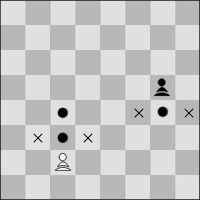
2. KNIGHTS
(The knight, Der Springer, Le cavalier, El caballo, A huszár)
Knights, they move like an L. Unlike other pieces they can hop over both their own pieces and those of the opponent.
The knight may leap tot any square in an "L" shape. It is the only piece which may jump over a piece in its way; since it does not pass directly over any intervening square, it cannot be blocked by any chess pieces.
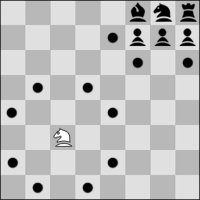
3. BISHOPS
(The bishop, Der Läufer, Le fou, El alfil, A futó)
The bishop moves to any square along a diagonal on which it stands - both backwards or forwards, as long as no piece is blocking its path.
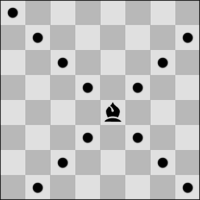
4. ROOKS
(The rook, Der Turm, La tour, La torre, A bástya)
They aren't gay, or at least they will always deny such allegations in public. They go straight.
The rook may move any number of squares horizontally or vertically, as long as no piece is blocking its path.
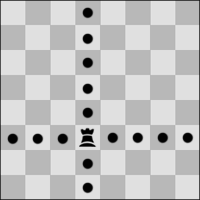
5. QUEENS
(The queen, Die Dame, La dame, La dama, A vezér)
OMG they can go, like, everywhere.
The queen may move any number of squares in any direction, as long as no piece is blocking its path. The Queen has the powers of a Bishop and Rook combined. The Queen cannot move as a knight.

The Bishop, Rook and Queen may not move over any intervening pieces.
6. THE KING
(The king, Der König, El rey, A király)
The King can move in any direction, but only one square at a time, provided no piece block his path. The King can capture in any direction as well.
The King may not move to a square:
occupied by one of his pieces;
where it is checked by an enemy piece;
adjacent to the opposing king (this would create a shortcircuit).
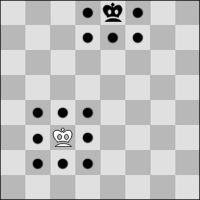 Extra cool moves
Pawns to the eighth rank: promotion
Extra cool moves
Pawns to the eighth rank: promotion
Once any pawn reaches its eighth rank (so the first rank for black pawns) its player must remove it from the board immediately and replace it with a piece of his own colour and must choose between queen, rook, bishop and knight. A pawn cannot promote into a King. All this counts as only one move. The next move it can be captured immediately. If not, this new piece can move immediately as if it never has been a pawn. Compare caterpillars and butterflies and think away the cocoon phase. If your original Queen hasn't been captured yet when you promote, you are still allowed to promote to a second Queen. If you don't have a queen of the right colour, you will need to snatch away one from your neighbours.
King and Rook: castling
(Castling, Die Rochade, Le roque, El enroque, Sáncolás)
If the King and Rook both haven't moved yet there is this rule that they can move simultaneously. The King moves two squares towards the rook and the rook jumps over it.
You cannot castle: if the king is in check (attacked by an enemy piece); if there is any piece between the king and the rook; if the king will be under attack by an enemy piece after the castling; if the square through which the king passes is under attack by an enemy piece; if the king or the rook (the one with which castling was going to happen) has already moved.
 The Ultrasecret move: en passant
The Ultrasecret move: en passant
This one catches the newbies all the time. It's called en passant, or e.p. for short.
(The en passant pawn capture, Das Schlagen des Bauern im Vorbeigehen (en passant), La prise en passant du pion, Eliminar al peón "pasando" (en passant), A menet közbeni (en passant) ütés)
The possibility of en passant pawn capture only arises directly after a pawn has taken advantage of its initial move of TWO squares forward.
If the pawn had moved only one square forward, an enemy pawn could have captured it. But the en passant move makes the capture possible anyway! Notice en passant must happen immediately and only a pawn can perform this special capture; en passant is only possible during the opponent's move immediately after the two-square jump.
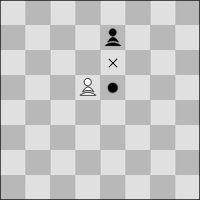 Capturing
Capturing
1. A piece may take over the square of an opponent's piece that stands within its reach, provided the squares between itself and the captured piece are vacant (exception to this rule is capturing with a knight, those do not conform to chess conventions). The opponent's piece is taken off the board and added to the player's collection of captured pieces, with which the player may try to build a
chess pile while he is sitting around during his opponent's moves. The captured piece will not participate in the game anymore, but don't destroy it or throw it away! It may come back when a pawn promotes (see section "Extra cool moves") or when you are starting a new game. You don't want to buy a new chess set for every new game you are playing. Your mileage may vary.
2. Tip! You can never capture a piece of your own colour. No more than one piece may stand on one square.
3. Capturing is always optional, unlike in inferior games such as Checkers® and Pacman®.
4. A King can never be captured. If a King of either player is attacked, it is announced by both players simultaneously yelling "CHECK!!!" (see below) and the owner of the King has to ensure the pending capture is taken away immediately. Only the moves that succeed to secure the King are considered legal. Long live the King! If there is no such move available while the King is under attack, the King is Check-mated®. Expert's Tip: keep your King safe because it is tedious to take him out of the opponent's checks all the time. A walking King under fire has a short shelf life.
5.
HINT: Generally if your opponent can capture one of your pieces, you will be wanting to capture at least the same strength of piece back immediately afterwards. i.e. if your opponent captures your Queen, it will not be sufficient to capture a single Rook. Two Rooks counterbalance a Queen nicely though. The hierarchy is explained in more detail below.
The Chess Hierarchy
An explanation of the pieces, followed by their relative market worth in
bold.
Your King is The Man. He's the coolest dude on the board. He doesn't have sons. He cannot be replaced.
$1,000,000.000,000,000.00
The Queen is his wife. After death she can be replaced by a mistress though (pawn, see "extra-cool moves").
$9.00
The Rook is the King's luxurious homebase. Use the special move "Castling" to close its door, which stops invaders. After that the King can relax and drink a beer or two amidst his friends.
$5.00
The Bishop is the King's clergy. He is working minimum wage and supposed to do a lot of the dirty laundry.
$3.00
The Knights are the chess board's thugs. They prefer to work at night when they cannot be seen. They hop around everywhere harrassing young girls and robbing old men's wallets. They're an unpredictable bunch. Sometimes, when they're too hung-over from the previous weekend, they stay home to protect their King; they do this excellently, even against seemingly overwhelming force, when placed on a square directly situated next to their own King.
$3.00
The pawns are the faceless middle class. Together they form a natural shelter for all your pieces... much like an egg's shell.... hmm, I like eggs..... Anyway, if you knock a boiled egg against another one, eventually one will break. Just like in chess. Never become too nervous and recklessly disconnect their natural bond; don't screw up and scramble your own egg.
$1.00
Check, Check, Check-mate®
The King is said to be "in check" if it is attacked by one or more of the opponent's pieces, even if such pieces are constrained from moving to that square because they would then leave or place their own King in check. No piece of yours can be moved that would expose your King to check, even if this move would attack the opponent's King - your King would simply be captured first, and with that the game would end immediately - any move made by you that would result in a position in which your King is attacked is simply "illegal". These pieces temporarily deprived of privileges are called "pinned pieces". They can move again once the pin is relieved. This can happen in quite a lot of ways actually, for example when the opponent moves away the pinning piece; the pinning piece is captured; some other piece is placed in between the King and pinning piece; the King is moved away. In some cases the pinned piece can actually move, provided it does not expose its King - an example of this is the pinned Queen; she can still move provided it is within the pinning line. You would probably end up losing her, though. Be careful! A player may never make a move which places or leaves his own King in check. Failing to do so is very naughty.
Touch it, move it
This is a rule that may seem strange to beginners. Once you touch a piece, you actually have to move it - even if it would be a very bad move. If you touch an opponent's piece, you actually have to capture it - with any piece possible, even if it would lead to the loss of a Queen. Why? Well, for one thing it would become very messy if both players would rearrange the whole chessboard during their move. After each move both players would have to verify the position is still correct, all pieces present, all pieces still on their right spots, except the piece that moved last. After each move the complete game would have to be replayed. No. That isn't going to work. Exceptions: if none of the pieces touched can be moved or captured, the player may make any legal move. Provided that you first express your intention - for example by saying "j'adoube" (French for "leave me alone") or simply "I adjust", you may adjust one or more pieces on their squares during your move.
For chess commercial purposes, this is a cool rule - because it shows to "Think before you act".
The recording of the moves
During the game, both players record the moves (see below) on a piece of paper with a pen or pencil. Usually specially preprinted Chess Notation Forms® are used because otherwise it would become too much of a mess. Some cool geeky dudes spend $359.00 on electrical devices but unfortunately for them it only makes them look like complete dolts.
Why record the moves? To prove what happened in the game - i.e. after an illegal move has already been executed, it is hard to prove the Bishop changed colours without knowledge of the history of the game. Another reason is to be able to replay the complete game afterwards and potentially learn from it (most though prefer binning the paper immediately after the game). To feed it to your computer chess engine and see how it boasts it would have won the gane from either side.
Some old Americans use the "Descriptive notation" which is hard to describe; in the computer age it is handier to use the "Algebraic notation" (also known as Chess Algebra Abacadabra). The pieces are denoted as K (King) Q (Queen) R (Rook) B (Bishop) N (Knight but the K was already taken) P (Pawn but usually the P is left out) O-O and O-O-O (castling Kingside, Queenside). The coordinates are used. Captures are denoted by an "x". Checks are denoted by a "+". Checkmate is "#". A draw offer is "=". So after 1. e4 e5 2. Nf3 Nc6 3. Qe2 a6 4. Qb5 axb5, the position is as follows:
The scoresheet may only be used for recording the moves, the times of the clocks, the offers of a draw, and matters relating to a claim and other relevant data. No drawings of your opponent's pompous mustache allowed.
The end of the game and the result
Both players maneuver around, one piece at a time, hitting the clock after each move. This goes on and on and on until a draw is agreed upon, most of the time when both players are bored and/or tired of playing, oftentimes after ten moves or so (especially if they're grandmasters). If one of both players refuses to offer/accept a draw offer, playing continues until all pieces (except Kings) have been captured.
Whatever the cold result, most of the time the game ends in disorder, confusion
, and aporia.
1. There is an infinite number of possible games, but there can be only three results; they are denoted as 1-0 (White wins), 1/2-1/2 (draw), and 0-1 (Black wins).
2. A player may offer a draw after any move. His opponent may accept, which ends the game, or make a move, and play goes on as normal.
3. A player may resign at any point, whether his opponent accepts or not.
4. If time is up, the Skull® appears and can be clicked. This ends the game in the skull clicker's favour.
5. If the exact same position with the same side to move has been on the board three times it's time to be realistic and call it a day. No progress can be made by either player or they should have deviated before. Draw.
6. If for fifty moves long neither player has captured any piece nor has made any pawn move, it's time to be realistic and call it a day. No progress can be made by either player. Draw.
7. If the King of the player to move is under attack and he cannot do anything about it using legal measures (this does not include kicking your opponent under the table), the game ends and his opponent wins. This is called Check-mate®.
8. If the King of the player to move is not under attack but cannot make any legal move either, his opponent is a numpty: it is stale-mate. This isn't quite the same as Check-mate®. It's a draw instead. The stalemated player laughs his opponent in the face and with a smile from ear to ear calls all his nerdy friends over to show them just how much of a loser you are. This moment will be haunting you for years to come. Silly chessplayers may not even know their own telephone numbers, but they never forget such displays of incapability on the chessboard.
After the game has ended, set the pieces back to the initial position (the captured ones as well, as if nothing happened to them), switch colours and start again. Or when either player is in a bad mood, put back the pieces in the specially designed Chess-box®.
Strategy and tactics
The result of a game depends to a considerable extent on the difference of the player's strengths (also called ratings), talent, study time spent, ingenuinity, creativity, intelligence, concentration, calculcation ability, endurance, tenacity, perseverance, self-discipline, killer instinct, energy, fanaticism, will to win, luck and a generally unlikeable character.
Don't forget Chess is the most boring game the world has ever come up with. It is mainly played by grumpy old men, people who wish to evade reality every now and then - or even better, permanently.
There is no fun, it is serious business. "Chess is mental torture".
The board is in perfect balance. Both players have exactly the same force and this force is distributed exactly the same way for both sides. But it is very hard to keep the balance. The black pieces cannot simply copy white's moves to keep the equality on the board. For example 1. e4 e5 2. Qg4 Qg5 3. Qxg5. White has one move more. Black cannot reply Qg5xg4. He is missing his Queen. The dam has been broken. The flood cannot be stopped from here. There is simply too much white power of which the threats and attacks cannot be countered with equal force. This doesn't mean that 2. Qg4 is actually a good move. It exposes the Queen to attacks and the Queen will have to move again after 2. ... Nf6. The balance has been disturbed. Black's position is better, based on having made two useful moves whereas white already has to make a second useless move with the Queen. But Chess is not this simple; it is very subtle in its ways. Sometimes these seemingly useless moves (not developing anything, being exposed to threats) may actually accomplish more than two "useful" developing moves. Here 3. Qg3 attacks e5 and g7 - reasonably the pawn on e5 has to be covered immediately, and the Bishop on f8 is kind of limited in its possibilities now. Moving it away would make castling Kingside more or less impossible after Qxg7. Still, moving away the Bishop from f8 would be possible (first something like 3. ... Nc6 to cover e5 4. Nc3) because after something like 4. ... Be7 5. Qxg7 6. Rg8 Qh6 black has this open line to enjoy for his Rook while the Queen is completely out of play. Black's King will eventually castle Queenside to seek safety. Black is OK. All these considerations... it is hard to stay on top of it all. The best solution to all this mess is to just look at the board, keep all your pieces covering one another and see what happens.
What makes Chess so Wonderful, what makes Chess worth spending time on
Hard to say. It is the most boring and wonderful "game" you can spend time on. Chess is interactive art - really. Try it for yourself.
You can obtain ratings nobody cares about, yet these (increasing) ratings are the crack that keeps the fire burning for many, the reason to return to the board. Feed your ego, beat stronger players. With every game you play you see more. You become better at it. Each new game should be better than all the ones before. Only difficulty is that the Chess pieces confuse you all the time, sometimes sending you into the wrong direction. That's why you won't become stronger by only playing games of chess. You also have to "study" (reading books written by people who want to make a quick buck out of this game), but these books may send your thoughts in the wrong directions as well. Chess is fuzzy like that.
For me, the reason I keep playing chess is because the pieces keep demanding moves from me (the manipulative bastards). When I play chess it is kind of a metaphor for "Leave me alone please, can't you see I'm playing chess?". I play Chess a lot. And I like it.
